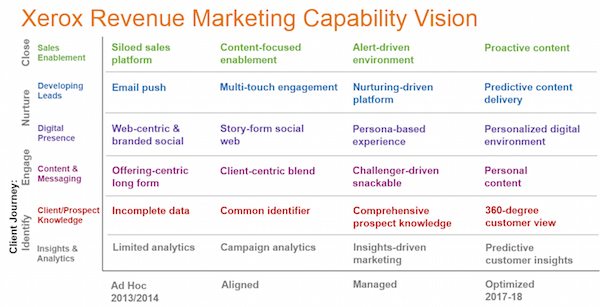I’ve come to believe that organizational culture is the quintessential competitive advantage.
That’s why, for all the tremendous changes underway in the world of marketing today, I’m most fascinated by the evolution of culture in marketing departments, as a function of new responsibilities, new technologies, and — most of all — new people with new skills and perspectives.
My presentation earlier this week on agile marketing was, at its core, a talk about culture.
One of the key trends in this cultural evolution of marketing is the entwining of analytics and analytical thinking into a discipline that must still continue to leverage a rich heritage of right-brain creativity and “softer” skills. Innovative mixing of these two mindsets in our emerging Age of the Customer is synthesizing a new kind of marketing — and perhaps more importantly, a new kind of marketing culture.
All this is a lead up to say that I’m excited to share with you the following Q&A with Adele Sweetwood, VP of SAS Americas Marketing. SAS is renown for its leadership in analytics and business intelligence software, but they’re also lauded as having shaped an amazing company culture as a strategic advantage. (Google’s founders actually sought their advice on culture when starting their venture.)
So who better to ask a few questions about analytics, marketing, and culture?
To start, can you tell us a little about your background and your role at SAS?
I am a Baby Boomer, borderline Gen X — who has grown up in the technology and software industry over the past 25 years. I have held positions in sales, marketing, education, consulting, and the majority of that time in a leadership or management position. I have an amazing modern family, cherished friendships, and I do my best to enjoy life.
In my current role at SAS for the Americas, a big component involves field-marketing efforts, which include interactive marketing, advertising investments and all the inbound/outbound campaigns. In my organization, we also provide analytical-marketing services, database marketing, customer-loyalty marketing and various customer-facing services, like a marketing contact center and an executive briefing center. Our objectives are focused on image development, demand creation, revenue and pipeline impact and the customer experience.
Organizationally, we are tightly aligned with sales, and we have a well-defined set of metrics. As a marketing organization, we’ve built a strong analytical culture that drives decision making and inspires innovation. We are highly credible with our partners, we are creative, accountable, and we deliver results.
Some marketers think that left-brain analytics and right-brain creativity are like oil and water. How have you found the two intertwine and complement each other in your own marketing organization?
In our organization, I would say that left-brain analytics and right-brain creativity are dependent on one another — and it works. I wouldn’t say oil and water. Probably more like peanut butter and jelly.
Creativity and analytics intertwine and complement each other in a very deliberate way, if the culture dictates it. We, by default have marketers that are creative. They are creative in their strategy, design, and implementation across marketing plans. We had to enable the analytical component more aggressively over time.
Creativity and analytics intertwine and complement each other in a very deliberate way, if the culture dictates it.
The market demands, channel explosion, digital revolution, and increased customer expectations all dictated this shift. Marketing has always had “metrics” and especially in the B2B space, some level of analytics in decision making. The shift has been in creating an analytical culture that empowers innovation; applying a level of analytics that enables you to combine fact-based decision making with creativity for optimum results. This environment encourages risk taking and rewards curiosity.
Another key aspect of merging creativity and analytics is around the data. Marketing organizations have some of the most valuable data in a company — customer data. And it’s growing in volume and complexity (unstructured and text data). Data is the “holy grail” component, and when leveraged through analytics, will tell marketers some of the most creative, well-written stories they have ever experienced. The right combination of creativity, data, and analytics is powerful.
As part of becoming data-driven, should marketers get more comfortable running controlled experiments? Can you tell us a little about the practice and culture of testing at SAS?
A data-driven analytical culture breeds “controlled experiments” — but more importantly, it supports continuous experimentation. While some testing can be set up from the beginning, it also needs to be agile and driven by the data.
A data-driven analytical culture breeds “controlled experiments” — but more importantly, it supports continuous experimentation.
The best news is that the digital marketing world fully supports testing, much more than traditional marketing channels ever did. We’ve taught marketers to value data as they would their own financial portfolio. Data needs to be managed and the quality needs to be maintained.
We expect continuous testing and improvements, with a bent towards innovation. But we don’t have a pure controlled testing plan. In some channels, like online advertising, there may be some very deliberate tests on campaigns, but on the whole, we encourage marketers to try different approaches, varying creative, and multiple channels constantly.
We can do that because we enable them with a “marketing analytics portal” — a view into their results. We also provide them with insights from the data and a deeper understanding of the digital dialogue of that customer or company. All of this data and information allows them to test and quickly measure subject lines, message, and segmentation techniques, which can then be used in future marketing efforts.
One specific example that comes to mind is how we are using web analytics to explore data about customer behavior on our website. When contacts visit our website to discover more about our product offerings, we can identify those who show interest and those who are not taking specific calls to action. These insights have resulted in changes to our website and allowed us to adjust our campaign communications to be more relevant and behavior specific. Through continuous testing, we have experienced reduction in opt-outs and significant uplift in conversion rates and pipeline impact.
Do you find that being data-driven accelerates the cycle speed of marketing? What kind of bottlenecks appear as you increase the velocity of marketing and how do you overcome them?
Being data-driven and analytical definitely accelerates the cycle speed of marketing. It can take out the guesswork and increase confidence in decision making. It allows for, and expects, an ongoing evaluation of outcomes that need changing or that establish best practices. Today’s customer demands dynamic — almost instantaneous — interactions with brands. This reality is the impetus for the cycle speed of marketing.
The data and opportunity for analysis have been present, but have now increased in value and necessity.
The bottlenecks come in many forms — capacity, resources, systems, etc. The key to overcoming any of them is communication and collaboration. None of us operate in silos anymore. It’s impossible because there is so much convergence of channels and campaigns. Nothing happens in a linear way, which makes it challenging to align efforts seamlessly. Marketing leadership has worked together to close any gaps and develop joint objectives that are intended to alleviate the bottlenecks.
None of us operate in silos anymore. It’s impossible because there is so much convergence of channels and campaigns.
The data and opportunity for analysis have been present, but have now increased in value and necessity for marketers. Marketers must not only be data-driven in their campaigns, but also in their marketing operations and planning (such as resource allocation, asset management, and so on).
As marketing becomes more savvy with data and software, how do you see that affecting the relationship between marketing and IT?
As we have been building out our analytical culture, one component has been around internal partnerships. Marketing has been increasing investment and emphasis in technology spending — on a broader scale and at a faster rate than many areas. That means, now more than ever, we better get along with IT. At the same time, IT has been undergoing its own changes and has had a focus on better understanding the business side at a strategic level. Essentially we both had to get better at walking in each others’ shoes.
Marketing has been increasing investment and emphasis in technology spending — on a broader scale and at a faster rate than many areas. That means, now more than ever, we better get along with IT.
There are a couple of key elements I would point out that make the relationship work.
The first is that the relationship needs to start at the executive levels and spread through the organization. There needs to be mutual respect and understanding established and demonstrated.
There were two specific actions that enhanced collaboration at SAS even further. First, we included IT in a collaboration workgroup called “Digitize the Business” that was formed across marketing organizations. The objective of this organization was focused on the customer experience, and modernizing communications across digital channels and campaigns.
The inclusion of IT has improved their understanding of marketing strategy as well as allowed us, as marketers, to learn about what might have been occurring across other parts of the organization as well as better appreciate the challenges IT might face. In conjunction with this effort, IT took the action of hiring a position dedicated to working with marketing. They established an integration analyst role that bridges marketing (business) and IT.
If you could offer one piece of advice to CMOs about making their organizations more data-driven, what would you say?
In the never ending quest of marketing to deliver value within an organization, CMO’s need to evolve their organizations from simply providing metrics, to gaining insight, and ultimately predicting outcomes. The only way to make that shift is to be more data-driven, but that isn’t sufficient. The data needs to drive fact-based decisions with an analytical culture.
My piece of advice would be to build and nurture an analytical culture across the entire marketing organization.
Build and nurture an analytical culture across the entire marketing organization.
Thank you, Adele!




Scott. Just thought I would say that this is a seriously great piece. Throughout the entire post my head was nodding in approval, my brain going “yes! That’s exactly right,” When I was completing my undergraduate degree, I entered a marketing case competition. The advice from our judges, CMOs and C-Suites, was overwhelming strategical. They kept emphasizing that while marketing is creative, it is also, highly analytical and strategical. Now working at Unbounce, I truly value the power of marketing analytics and incorporating this analytical thinking across a marketing organization is clearly what we want from our customers (and we obviously practice what we preach as well). Again, great piece!
Thanks, Stef — glad you enjoyed this!